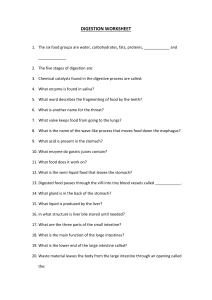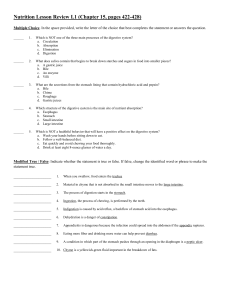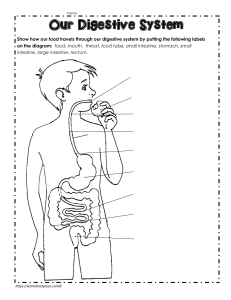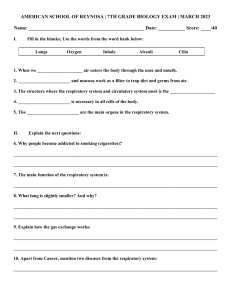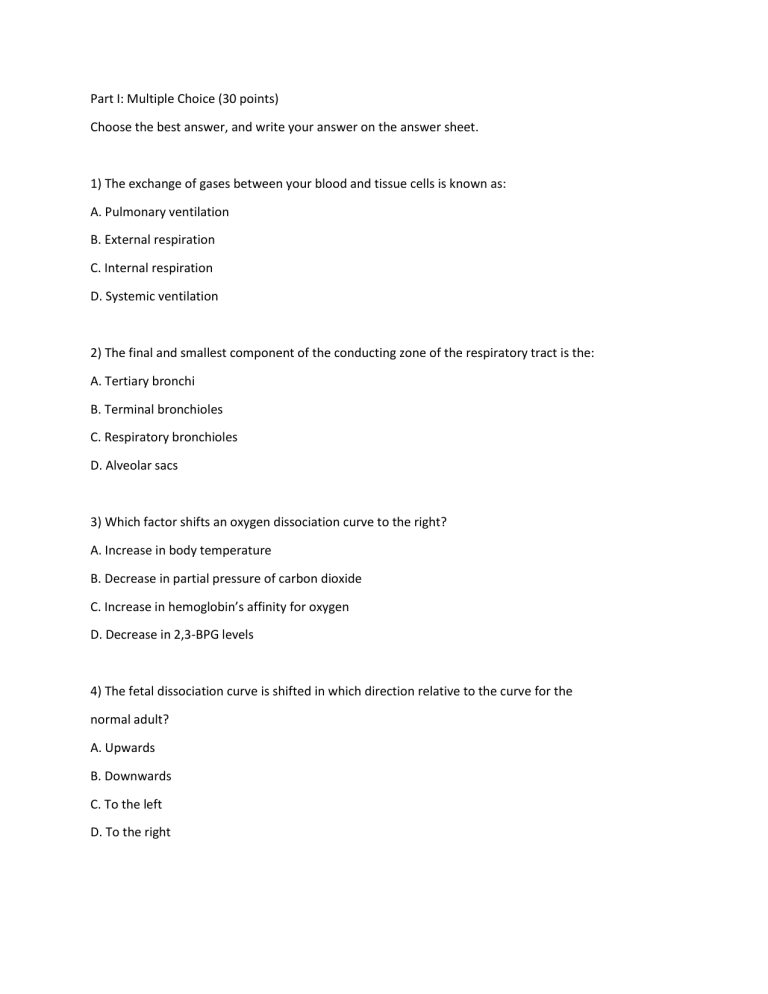
Part I: Multiple Choice (30 points) Choose the best answer, and write your answer on the answer sheet. 1) The exchange of gases between your blood and tissue cells is known as: A. Pulmonary ventilation B. External respiration C. Internal respiration D. Systemic ventilation 2) The final and smallest component of the conducting zone of the respiratory tract is the: A. Tertiary bronchi B. Terminal bronchioles C. Respiratory bronchioles D. Alveolar sacs 3) Which factor shifts an oxygen dissociation curve to the right? A. Increase in body temperature B. Decrease in partial pressure of carbon dioxide C. Increase in hemoglobin’s affinity for oxygen D. Decrease in 2,3-BPG levels 4) The fetal dissociation curve is shifted in which direction relative to the curve for the normal adult? A. Upwards B. Downwards C. To the left D. To the right 5) Which of the following is not an effect of high altitudes on the respiratory system? A. Pulmonary artery pressure decreases B. The saturation of oxyhemoglobin begins to decrease rapidly C. Hyperpnea D. Hypoxia 6) Which nerve in the body controls the diaphragm muscle? A. Phrenic nerve B. Thoracodorsal nerve C. Intercostal nerves D. Vagus nerve 7) Which gas law states that the volume of a given quantity of gas is directly proportional to its absolute temperature? A. Boyle’s law B. Charles’ law C. Henry’s law D. Dalton’s law 8) If Bob’s vital capacity is 4800 mL and his inspiratory capacity is 3700 mL, what his expiratory reserve volume? A. 1100 B. 8500 C. 6000 D. 3000 9) What is the name of the cavity in which the heart sits in between the two lungs? A. Cardiac notch B. Mediastinum C. Pleural cavity D. Bulla 10) Which of the following describes the mechanism of sneezing? A. Long drawn deep inspiration followed by complete closure of rima glottidis B. Spasmodic contraction of muscles of expiration C. Long drawn and deep inspiration followed by shorter more forceful expiration D. Inspiration followed by many short convulsive expirations 11) How many waves of peristalsis occur in the esophagus? A. 1 B. 2 C. 3 D. 4 12) Which of the following is not a layer of the mucosa? A. Epithelium B. Lamina propria C. Muscularis externa D. Muscularis mucosae 13) In the tongue, which are the most abundant forms of papillae? A. Fungiform B. Filiform C. Vallate D. Foliate 14) Where does the majority of chemical digestion in the stomach occur? A. Fundus and body B. Cardia and fundus C. Body and pylorus D. Body 15) Which of these nutrients is absorbed mainly in the duodenum? A. Glucose B. Iron C. Sodium D. Water 16) Which cells secrete gastric intrinsic factor? A. Chief cells B. Parietal cells C. Enteroendocrine cells D. Foveolar cells 17) What are the common terms for mastication and deglutition? A. Swallowing; chewing B. Chewing; spitting C. Chewing; swallowing D. Swallowing; spitting 18) In which region are brush border cells not found? A. Kidney B. Large intestine C. Small intestine D. Stomach 19) What is a common way to test if someone has appendicitis? A. Perform a colonoscopy B. Touch McBurney’s point on patient C. Barium swallow, followed by x-rays D. Biopsy 20) Where is chime converted to feces? A. Rectum B. Colon C. Anus D. Ileum 21) Which immune cells complement both specific and nonspecific defenses? A. Natural killer cells B. Eosinophils C. Macrophages D. Mast cells 22) What is the process called where leukocytes pass through capillary walls during the inflammatory response? A. Margination B. Leukocytosis C. Diapedesis D. Chemotaxis 23) What is it called when immune complex formation blocks specific sites on virus or toxin & prohibit binding to tissues? A. Precipitation B. Agglutination C. Complement fixation D. Neutralization 24) Which immunoglobulin functions mainly as an antigen receptor on B cells that have not been exposed to antigens? A. IgA B. IgG C. IgD D. IgM 25) When a person receives a vaccine, his or her body: A. receives antibodies against a specific pathogen B. immediately begins to fight the infection caused by the pathogens C. creates plasma cells that can produce antibodies against the specific pathogen D. creates antigens to fight the specific pathogen. 26) Hemolytic disease of the newborn (HDN) can occur when: A. the mother is Rh negative and baby is Rh positive B. the mother is Rh positive and baby is Rh negative C. the mother is Rh negative and baby is Rh negative D. the mother is Rh positive and baby is Rh positive 27) In which disease does cancer start in B-cells, and is characterized by a large and fastgrowing tumor? A. Follicular lymphoma B. Burkitt’s lymphoma C. Mantle cell lymphoma D. Hodgkin’s lymphoma 28) Which of the following is the only lymphoid organ that does not directly fight antigens? A. Spleen B. Thymus C. Tonsils D. Appendix 29) Which of the following molecules is not generally produced by T cells and macrophages? A. growth-inhibiting factors B. cytokines C. colony-stimulating factors D. tissue thromboplastin 30) Hypersensitivity reactions: A. are sometimes mediated by IgE B. may involve immune complexes C. may involve complement, histamine, neutrophils or IgG D. all of the above. Part II: Fill in the Blank (30 points) Choose the best word or words, and write your answers on your answer sheet. 1) When the diaphragm relaxes, the thoracic cavity __________ in size. 2) Alveolar macrophages are also called __________. 3) When you laugh while eating, the __________ begins to move back, but is thrust forward suddenly, sending the contents of your mouth to your nasal cavities to fly out of your nose. 4) The respiratory mucosa is made up of __________ epithelium. 5) During exhalation, __________ intercostals muscles and other muscles can be stimulated. 6) Accelerated respiration is also known as __________. 7) The lung’s ability to stretch and expand is referred to as __________. 8) A __________ is an abnormal collection of air in the pleural space between the lung and the chest wall, resulting in a collapsed lung. 9) __________ is a category of respiratory disease characterized by airway obstruction. 10) Clubbing in the fingers is a common symptom of __________. 11) Saliva contains __________, an enzyme that digests starch. 12) Lipases break fat globules down into smaller droplets, a process known as __________. 13) Nutrients are absorbed into capillary blood and are transported to the liver via the __________. 14) One theory about the function of the appendix states that it serves as a reservoir to __________. 15) The two major lobes of the liver are divided by the __________. 16) The pancreas produces __________, which helps counter the acidic quality of chyme that enters the duodenum from the stomach. 17) The large intestine and undergoes several muscular contractions called __________, which propel the colon towards the anus to help move food. 18) If a tumor affects the digestive system, it is called a __________. 19) A __________ ulcer can penetrate through the wall of the stomach or small intestine, allowing the luminal contents to leak into the abdominal cavity. 20) More than 80% of colorectal cancer cases arise from a certain form of polyp called __________ polyps. 21) __________ or ear wax protects the ear canal by trapping dirt and dust particles. 22) The __________ immune response defends against intracellular pathogens and cancer by binding to and lyzing the infected cells or cancer cells. 23) __________ T cells play a role in transplant rejection. 24) The inflammatory response is characterized by swelling, pain, redness, warmth, and __________. 25) Substances that induce fevers are called __________. 26) __________ is an autoimmune disorder characterized by a butterfly rash. 27) There are __________ types of hypersensitivity. 28) Type 1 diabetes is caused by the destruction of __________ in the pancreas. 29) Secretions from mucous membranes (saliva, tears, sweat, etc.) contain antimicrobial proteins such as __________, which break down bacterial cell walls. 30) __________ asthma is the more common form of asthma, and it typically develops during childhood.
